Folder Formats
This page lets you configure the Folder Formats system, which lets you define
folder formats (display parameters) for specific folders, folders containing
certain types of files, or defaults for certain types of folders. For example,
you can make it so that Opus automatically sorts a particular folder by date in
reverse, or switches into thumbnails mode in any folder containing mostly
images.
The Folder Formats system is powerful but rather complex. There's an FAQ on it at
the Resource Centre that we recommend you have a read of as it may explain
things in a bit more detail than this help file does.
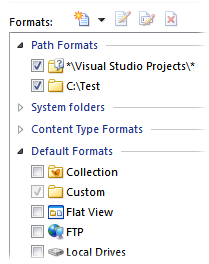
The Formats list is grouped into different sections:
- Path Formats: This group contains formats that have
been defined for specific folders. You can also define a format for a path
using a wildcard string - in the screenshot above, a format has been defined
for any path below a folder called Visual Studio Projects, as well as
for the folder C:\Test.
- System folders: Contains formats that can be defined for
certain special locations. There are currently only two formats in this group
- the Computer folder, which is used when Opus displays My
Computer itself rather than hosting Explorer, and the Portable
Devices folder, which is used when viewing the root of the mtp:// namespace.
- Content Type Formats: The Content Type section contains
formats that are defined for file
type groups. When the Content Types system is enabled, these formats
will be used automatically when a folder containing enough of those types of
files is read. For example, the Content Type format for the Images group can
be set to switch the display into thumbnails mode. If you navigated to a
folder that contained mostly images, this format would be applied
automatically.
- Default Formats: This section defines the default formats
that are used for certain types of folder when a specific format hasn't been
defined. The default types are:
- Collection: The default format for File Collection folders.
- Custom: This is the over-all default format that is
used if no other format has been defined (see below).
- Flat View: This specifies a format that is applied
whenever a file display is put into Flat View mode.
- FTP: The default format for FTP sites.
- Local Drives: The default format for folders located on
local drives (fixed hard drives like C:).
- Network Drives: The default format for folders located
on network drives.
- Portable Devices: The default format for folders
located on portable devices (like phones and cameras).
- Removable Drives: The default format for removable
drives like USB flash drives.
- Search Results: The default format for a File
Collection that is used to present search results. This will override the
Collection format for these collections.
- Synchronize: This is a format that is applied whenever
the Synchronize tool is
used.
- ZIP: The default format for ZIP files.
- Favorite Formats: These are formats that aren't linked to
a specific folder, but instead can be applied quickly to any folder through a
drop-down list in the Lister's Folder Options menu.
You'll notice that some formats in the list have checkboxes - this lets you
turn a format on or off (in the case of Path Formats, it lets you temporarily
disable a format without deleting it from the list).
Whenever you navigate to a new folder, Opus consults the Formats list to work
out what format to display it with. The list is searched from top-to-bottom:
- First, if a Path Format has been configured for that
specific folder, or the folder matches a configured wildcard format, it
will be used.
- Secondly, the Content Types system is checked if enabled.
If the folder contains enough files to meet the requirements of one of the
Content Type formats, that format will be used.
- Next, if no other format has matched, the Default Format
for that type of folder or drive is used. In the screenshot above,
however, all the Default Formats are turned off, and so...
- Finally, if a Default Format hasn't been configured (or
is turned off), the Custom format is used. This is a
"catch-all" format that can never be turned off and represents the underlying
default format for all folders.
(As a side note: There are some cases when the above doesn't happen when you
navigate to a new folder. If you have edited the format in the current file
display with the Folder
Options dialog, step 4 does not take place - your manually
edited format will be maintained until you navigate to a folder with its
own specific format defined. And if you have the format lock turned on, the format will
never automatically change).
To edit the formats, use the toolbar buttons at the top of the page:  (add a new format),
(add a new format),  (edit an existing format),
(edit an existing format),  (rename a Favorite format) and
(rename a Favorite format) and  (delete a format). Clicking the
Add button displays a drop-down menu that lets you select the
type of format to add:
(delete a format). Clicking the
Add button displays a drop-down menu that lets you select the
type of format to add:
- Path Format: a format for a specific path.
- Wildcard Path Format: a format for any path that matches
the specified wildcard pattern. You can define the pattern using the standard
Opus wildcard
system, or using regular expressions.
- Content Type Formats: Actually this option doesn't do
anything except open the File
Types dialog for you. Content Type formats are based on File Type Groups, and so to add a
new Content Type you have to use the File Type editor to add a new group. Once
you add the group through the File Type editor, it will appear in the Content
Types section in the Formats list and you can then define the format for it.
- Favorite Format: You will be prompted for the name of the
new format.
As well as using the toolbar buttons, you can also:
- Double-click a format to quickly edit it
- Right-click a format to copy its definition and paste it into another, an
existing format to your favorites list, or copy the definition of a favorite
format into another format.

When you edit a format Opus displays the Edit
Format dialog. This dialog contains several tabs with options that
control various aspects of the folder display. Each tab contains several
sections and these sections can be enabled or disabled separately. When a
section is disabled the options within that section are not applied to the
display even when the format itself is used. This means that "more specific"
formats (like a Path Format for a certain folder) can inherit settings from
"more general" formats like one of the Defaults. For example, the wildcard
format for Visual Studio Projects in the screenshot above does
nothing except set the file display to be grouped by Date modified. The rest of
the display parameters will come from the applicable default format.

The Columns tab lets you configure which information fields
(columns) are displayed for the folder when the file display is in Details or
Power mode. The selection of columns also has an impact on other display modes
like Thumbnails - even if the columns aren't displayed, you can only sort or
group by columns that have been enabled. The drop-down list at the top-right
lets you select from a number of different categories of fields (if you select
All you'll see there are actually quite a lot of fields, so dividing
them into categories makes it a lot easier to find the one you're looking for).
The fields in the chosen category that aren't currently enabled appear in the
list on the left, and the enabled fields are shown on the right. To move a field
from one list to another you can double-click it, drag and drop it, or use the
left and right arrow buttons between the two lists.
In the list on the right, you can change the order the columns will appear in
the file display by drag and drop or using the up and down arrow buttons. You
can also re-order columns in the file display itself by dragging the column
headers around.
The Width column in the fields list lets you specify the
width for individual fields - move the mouse cursor over the column and click to
edit the width setting (which is given in pixels). If no width is specified, a
default width (or automatic width) is used.
The Sort column indicates which field the list will be
sorted by. If a single checkmark is shown, there is only one sort field (in the
screenshot above, we're sorting by Filename). If a number with an arrow
symbol is shown it indicates multiple sort fields. To change the sort field,
single click in column on the desired field. To assign multiple sort fields,
click on the first field as normal, then hold either the Control
or Shift keys and click on the second field, then the
third, and so on. If you Control/Shift-click a
field that is already sorted, the direction of the sort for that field only is
changed - so you can for example sort by size in one direction and date in the
other.
The Group column lets you choose which field (if any) the
list is grouped by.
To group by a particular field, click on it in this column - click again to
reverse the group direction, and click a third time to turn the grouping
off.
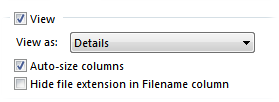
On the Display tab, the View section
contains options relating to the view mode of the file display.
- View as: you can have the file display automatically
switch to thumbnails, or details, for example.
- Auto-size columns: This option causes column widths
in details and power mode to be automatically sized to fit their contents.
- Hide file extension in Filename column:
This does just what it says - you might want to enable this if you
have added the separate Extension column (or if you just hate file
extensions!)
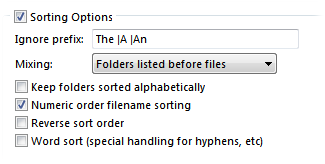
Also on the Display tab, the Sorting
Options section contains options that affect the sorting of the file
list (other than the actual field or fields the list is sorted by - this is
specified on the Columns tab).
- Ignore prefix: This lets you specify one or more filename
prefixes that Opus will ignore when sorting the file list. The screenshot
above shows that The |A |An has been
given, which means a leading The,
A or An (all three are
followed by a space) at the beginning of a filename will be ignored when
sorting. If you specify more than one prefix you must separate them with a
vertical bar character as shown above.
- Mixing: This option lets you choose how files and folders
are to be sorted with respect to each other. You can choose to list all the
files before the folders, all the folders before the files, or to have files
and folders interspersed.
- Keep folders sorted alphabetically: With this option on,
folders will always be sorted alphabetically even when the list is sorted by
another field. This doesn't apply if you have chosen Mix files and folders
together for the Mixing option.
- Numeric order filename sorting: This option changes the
way files and folders that begin or end with a number are sorted by name. When
off, digits in names are treated like any other character when sorting.
When turned on, digits at the beginning or end of a name are sorted
based on their numerical value.


The
image on the left shows an example of sort order when numeric order sorting is
off; the image on the right is with it on.
- Reverse sort order: This option reverses the order of the
sort - for example, if the sort is normally from A to Z, it would instead be
from Z to A.
- Word sort: This option enables special handling for
punctuation characters in filenames. In a word sort, all punctuation marks and
other non-alphanumeric characters, except for the hyphen and the apostrophe,
come before any alphanumeric character. The hyphen and the apostrophe are
treated differently than the other nonalphanumeric symbols, in order to ensure
that words such as "coop" and "co-op" stay together within a sorted
list.


In the image on the left, word sort is
turned off; it is turned on in the image on the right.
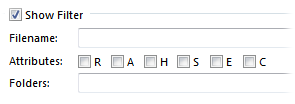
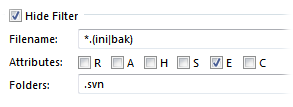
On the Filters tab are two similar sections; Show
Filter and Hide Filter. They can be used to control
which files and folders are shown and which are hidden when the format is
applied to a folder. The Show Filter causes files to be hidden if they
don't match the filter, and the Hide Filter causes files to be
hidden if they do match.
The Filename and Folders field both take a
wildcard string expressed using standard pattern matching. The
Attributes field lets you filter files and folders based on
their attributes - if any of the checked attributes are set on the item, it will
match the filter and be shown or hidden as applicable. The attributes checkboxes
correspond to Read-only, Archived,
Hidden, System, Encrypted and
Compressed.
In the screenshot above you can see that nothing has been defined for the
Show Filter, but the Hide Filter is set to hide any files that end in
.ini or .bak, any folder called
.svn (no wildcards were used so the folder name must match
exactly), and for no reason in particular, any files with the E
(encrypted) attribute set.
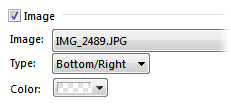
The first section on the Options tab lets you define a
background image that the format will apply whenever it is active. This can be
nice to use with the Content
Types system; for example, you could have a background image of a music note
that appears whenever the Music Content Type format is in use, as a visual cue
that you are in a music folder. The Image drop-down lets you
define the image to use - the images in this list are added to Opus using the Display / Images Preferences page. You
can control the position of the image in the file display with the
Type drop-down. The Color field lets you
assign a background color for the file display that will override the color set
in the Display / Colors and
Fonts section. In the above screenshot, no color has been specified - this
is indicated by the "transparent" checkerboard pattern.
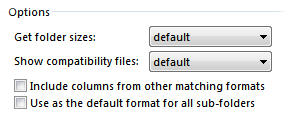
The final section contains general Options for the format.
Note that unlike the others, this section can not be turned off.
- Get folder sizes: Use this to specify whether folder
sizes are calculated automatically for sub-folders when this format is
applied. If set to Default the setting in Folders / Folder Behavior will apply instead.
- Show compatibility files: If this is turned on, Opus will
automatically display the contents of the compatibility folder along with the
current folder, if applicable. If set to Default, the setting in Folders / Folder Display will
apply.
- Include columns from other matching formats: This option
affects which columns are displayed when this format is in use. If turned off
(and the checkbox for the Columns page is enabled), the only
columns displayed in details or power mode will be the columns defined by this
format. If this option is turned on, then the columns defined by this format
will be displayed, as well as the columns for any other formats that match
the current folder. In this case, the method used to find a folder format
described above is modified slightly. The first matching format is still used,
but the search doesn't stop immediately - Opus will continue down the order of
priority looking for other formats that match, and apply any columns (and only
columns - no other settings) that those formats define. This process stops as
soon as a matching format is encountered that doesn't set the Include columns
from other matching formats option.
- Use as the default format for all sub-folders: This
option is used with path formats - if turned on, the format defined for a path
will also be used for any sub-folders under that path, unless they have their
own specific path format defined as well.


 (add a new format),
(add a new format),  (edit an existing format),
(edit an existing format),  (rename a Favorite format) and
(rename a Favorite format) and  (delete a format). Clicking the
Add button displays a drop-down menu that lets you select the
type of format to add:
(delete a format). Clicking the
Add button displays a drop-down menu that lets you select the
type of format to add:










